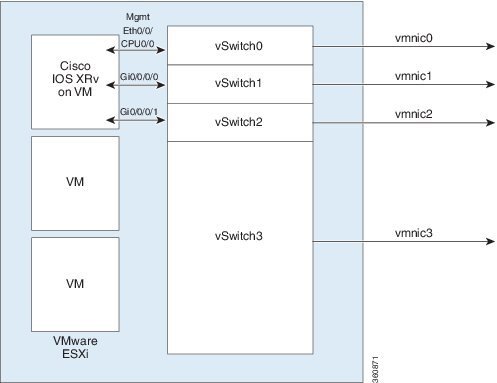Mapping the Cisco IOS XRv Router Network Interfaces to VM Network Interfaces
This chapter covers information about mapping the Cisco IOS XRv Router network interfaces to vNICs, adding and deleting network interfaces, and mapping them with vSwitch interfaces.
- Mapping the Cisco IOS XRv Router Network Interfaces to Virtual Network Interface Cards (vNICs)
- Mapping Cisco IOS XRv Router Network Interfaces with vSwitch Interfaces
Mapping the Cisco IOS XRv Router Network Interfaces to Virtual Network Interface Cards (vNICs)
The Cisco IOS XRv Router maps the Ethernet network interfaces to the logical virtual network interface card (vNIC) name assigned by the VM.
When the Cisco IOS XRv Router is booted for the first time, the router interfaces are mapped to the logical vNIC interfaces that were added when the VM was created. Figure 5-1 shows the relationship between the vNICs and the Cisco IOS XRv Router interfaces. The first vNIC added is automatically mapped to the ManagementEthernet interface port. All subsequent vNICs added are mapped to router interfaces. A maximum of 128 router interfaces (including the ManagementEthernet interface) are supported.

Adding and Deleting Network Interfaces on the Cisco IOS XRv Router
The Cisco IOS XRv Router maps the router Ethernet interfaces to the logical vNIC name assigned by the VM, which in turn is mapped to a MAC address on the VM host.
To add or delete a vNIC from the VM, you must first power down the VM. If you delete any vNICs, the router must be rebooted. For more information about adding and deleting vNICs, see the VMware Documentation.
 Caution |
Cisco recommends using caution before removing any existing vNICs on the Cisco IOS XRv Router VM. If you remove a vNIC without first updating the Cisco IOS XRv Router network interface configuration, you risk a configuration mismatch when the router reboots. When the router reboots and a vNIC has been removed, the remaining logical vNIC names could get reassigned to different MAC addresses. As a result, the Ethernet network interfaces on the Cisco IOS XRv Router could get reassigned to different vNICs. |
Mapping Cisco IOS XRv Router Network Interfaces with vSwitch Interfaces
You can configure the network interfaces in ESXi in different ways to accommodate the Cisco IOS XRv Router interfaces. shows an example where each Cisco IOS XRv Router router interface is mapped to one host Ethernet interface.

shows an example with multiple Cisco IOS XRv Router interfaces sharing one host ESXi Ethernet interface.

shows one Cisco IOS XRv Router interfaces mapped directly to a trunk interface on the vSwitch.

 Feedback
Feedback